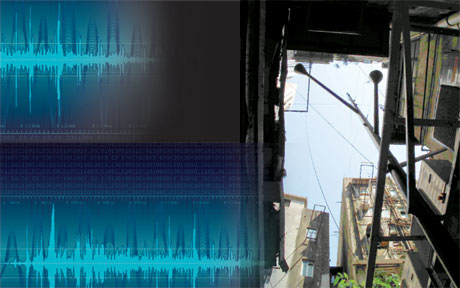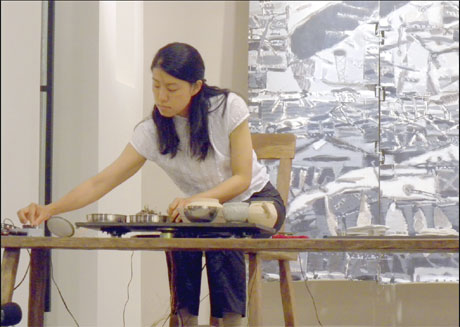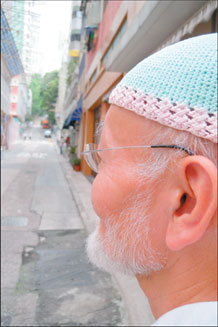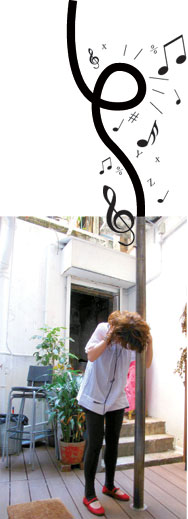Do you hear what I hear?
Updated: 2010-09-21 06:44
By Joy Li(HK Edition)
|
|||||||

|
Small Sound live performance by Germany-based artist Miki Yui. Provided to China Daily |
The art of listening is becoming lost as people become attuned to the blast of urban traffic, construction sounds, and blaring loudspeakers. Still, there are those who hope to revive the lost art and get people listening again. Joy Li reports.
On a stroll up the slope of an old, narrow lane, clustered with stalls that sell every imaginable description of goods, in a corner of Central obscured in the shadows of the city's highrise, one comes to a stained doorplate, whose barely discernible characters read the 8th, Hong Kong Architecture Centre (HKAC).
In the back of the building stands a curious tree-like edifice called the sound tree.
|
Japanese artist Akio Suzuki listens on the street. Provided to China Daily |
The odd sounds emerging from the 9-meter bronze sculpture recall what will become a piece of Hong Kong history.
"What it documents is the activities of the very last family in this old Chinese building. Because of the urban redevelopment plan, other families had all moved away," explains Platteen Tsang, the center manager.
Cupping an ear to the narrow opening on the "trunk" one hears the indistinct murmur of voices, light footsteps, kitchen sounds of food being prepared. The sound is amplified by two horns, or "branches" higher up on the sculpture.
Sound Tree is an installation featured at this year's Around Sound Art Festival, an event organized by Soundpocket, a local charitable organization supporting various sonic practices including the art of listening. Though the three-week event has ended some of the works are being preserved as a reminder of nearly imperceptible sounds that are often neglected or even displaced through the passage of time. Sound Tree is being preserved. "When the building will be pulled down? Some day, I don't know," said Tsang.
Sound Tree was conceived by Hong Kong-based artist Jaffa Lam last May. She has been involved in public sculpture and community projects in the city. The original plan was twin installations erected at both ends of Peel Street in Central, one on the footbridge over Caine Road and the other at HKAC. Only the one in the backyard of HKAC was completed. The government body that was asked to host the other statue declined.
Lam researched the neighborhood, talked to the people who live upstairs in the old house, and learned about their daily lives. She found out what time they get up in the morning, make lunch, and chat over tea. She and another Hong Kong artist, Cedric Maridet, assembled a study of the area's soundscape.
"I would say Jaffa's work is an intervention of that space, to be conscious or critical of what is happening," says Yeung Yang, who founded Soundpocket in 2008 and currently teaches at the Chinese University of Hong Kong where she earned her PhD in Intercultural Studies.
In a city crawling with a veritable blitzkrieg of visual images, its acoustic features however offer little variation and give rise to little comfort. Figures available from the Environmental Protection Department show that around 1 million people were exposed to traffic noise measured above 70 decibels in 2006. Noise at that level is capable of producing anxiety and stress. Various efforts by engineers and scientists have been made to build shields as a defense. Another option is to nurture active listening. Though in a league of its own and shared among a rather small circle, Soundpocket aims to "bring the audience's attention back to listening itself," as its founder puts it. After two consecutive Around Sound Art Festivals the group already is planning its next endeavors.
In 2003, a work by Luxembourg artist Tse Su-mei touched Yeung. It was a video installation titled "L'echo", and the artist played the cello in a green valley. It "stirred up something in me," Yeung recalled.
In the following years, as Yeung nurtured her own appreciation of sound art and collaborated with others who work with sound, she began to feel "we have sort of forgotten this sense. Maybe it is time to give it some sparkle, to remind us." This sparkle gave birth to Soundpocket in 2008.
Deep Listening
|
A visitor cups an ear to the narrow opening on the "trunk" of the sound tree at Hong Kong Architecture Centre. Provided to China Daily |
Walking down city streets, people expect a hotchpotch of messages from big screens. They hear loudspeakers blaring other messages and a lot of roaring around. It would be in vain to try to discern the diverse elements of the roaring. You may ask, why bother? Yet the indifference behind this attitude is the reason for Yeung's concern, that is, "the messages are numbing our senses."
The impact can be subtle and gradual. There also are those grating, unpleasant sounds for which there is no "off" button.
The glittering skyline of Hong Kong, captured and sent round the world on postcards, also has a role to play in all the cacophony.
"The dense and tall buildings amplify the sound, which bounces against the walls and travels a long distance," said Yeung.
She remembered a friend who visited Hong Kong. Walking around in Wan Chai area, the sound designer came across "A Symphony of Lights," a performance awarded the world's "largest permanent light and sound show" by the Guinness Book of World Records. The show, according to its introduction on the Tourism Commission website, is staged every night at 8 pm. What is spectacular about this? Forty-four key buildings on both Hong Kong Island and Kowloon participate in this show by shining lights in accordance with a musical rhythm. With all of Victoria Harbor serving as the stage and the sound powerful enough to go beyond the area, the show is bound to draw an immense audience.
However, the message it tries to convey, "to showcase the vibrancy and glamorous night vista of Victoria Harbor," may be so strong that Yeung's friend felt afraid. She said, "it was like bombs exploding around."
Ayumi Adachi is a Japanese painter who has lived in Hong Kong for 15 years. She has been assisting Soundpocket at the art festival. She describes the soundscape of the city through a painter's intuition. "You can imagine it like a wave, with distinct highs and lows across different regions," she says. In Stanley where she lives, the environment is so quiet that she says the chirping of birds is the most prevalent sound. In Causeway Bay noise prevails.
At this year's Around Sound Art Festival, Japanese artist Akio Suzuki continued his "Oto-date" practice which he started 10 years ago. He chose various spots in the city and painted ears and footprints in white on the thoroughfares. Then he invited people to "stand on the painted images and focus on listening" on the streets in Causeway Bay, Wan Chai, and To Kwa Wan, and he called it "a self-study event."
"We can train our ears back to the mode of Deep Listening," says Yeung. By Deep Listening, initials capitalized, she refers to the term coined by US composer Pauline Oliveros in 1991. As stated by the Deep Listening Institute which has been practicing this philosophy, Deep Listening "distinguishes the difference between the involuntary nature of hearing and the voluntary selective nature of listening."
"It means we can be sensitive to what we are listening to. The point is not to prioritize the ear, but to recognize that our senses are so powerful, we cannot afford to waste them," says Yeung.
(HK Edition 09/21/2010 page4)


